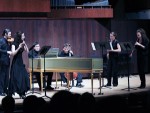Title
After an extremely busy and successful first year, the new Historical Performance program at Juilliard begins its second year with continued growth both in terms of size and scope of activities. The program, begun with 13 students last year, has grown to its expected standard complement of 24 masters and graduate diploma students. While maintaining its current core of major instruments offered, the program has also expanded to offer secondary lessons in Baroque trumpet, horn, and viola da gamba. The student ensemble of the program, Juilliard415, will begin its second season with a concert on October 7 in the Peter Jay Sharp Theater. The concert, which showcases works of J.S. Bach, will be led by Monica Huggett, Historical Performance’s artistic director.
Body
Continuing the collaboration with the Juilliard Vocal Arts Department that began last year, this concert will feature two Bach cantatas. The first, Ich habe genug, BWV 82a, is a solo cantata from Bach’s Leipzig years. Written for the Feast of the Purification of the Virgin Mary in February 1727, it was scored for bass soloist with oboe obbligato and strings. Bach later revised it for performances in subsequent years into the version that Juilliard415 will perform with soprano soloist, flute obbligato, and strings. It is written in five movements on an anonymous text dealing with the expectancy of death.
The other cantata featured on this program is Süsser Trost mein Jesus kommt, BWV 151. Also from the Leipzig years, Bach composed it in 1725 for the third day of Christmas. This cantata, written in five movements like Ich habe genug, contains solo arias for alto and soprano, and recitative for bass and tenor with a closing chorale. It is scored for strings with flute and oboe d’amore. Though rare in post-Baroque music, the oboe d’amore—an oboe a minor third lower than its soprano counterpart and with a special bulb shaped bell—was a favorite of Bach in Leipzig. It was especially useful, because of its transposition, for writing in sharp keys.
Two of Bach’s orchestral suites, Nos. 1 in C Major, BWV 1066, and 4 in D Major, BWV 1069, will complete the program. The four orchestral suites of Bach, labeled overturen by the composer, are in the form of dance suites with overtures. The dance movements of both suites include pairs of minuets, gavottes, and bourées where the texture is varied between orchestral tutti and wind or string soli. The suites also include some less common dances such as the forlane and passepied.
Last year, Huggett and Ensemble Sonnerie, along with fellow Juilliard Historical Performance faculty member Gonzalo Ruiz, were nominated for a Grammy Award for their recording of the Bach suites titled Orchestral Suites for a Young Prince. In this recording, on the Avie label, and in the upcoming performance by Juilliard415, Huggett gives a distinctly different take on the orchestration of the Fourth Suite in D Major. Typically, both modern and historically informed ensembles perform Suites Nos. 3 and 4 with trumpets and timpani. Huggett, however, alleges that these instruments were added later, possibly by one of Bach’s sons, and that the original orchestration of Suite No. 4 is strings with three oboes and bassoon. Such an ensemble represents the forces that the Prince of Anhalt-Cöthen, whom Huggett claims the suites were written for, had at his disposal.
This all-Bach concert is the first of a number of performances from the students and faculty of the Historical Performance program this year. Later in the fall, Juilliard415 has concerts scheduled with Nicholas McGegan and William Christie, and will collaborate with Juilliard Opera for Monteverdi’s L’incoronazione di Poppea, conducted by Harry Bicket and directed by Edward Berkeley. On October 21, the faculty ensemble, Juilliard Baroque, will present a program of Classical chamber music including the Mozart Flute and Oboe Quartets.





